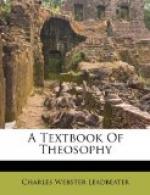We have given names to these interpenetrating worlds for convenience in speaking of them. No name is needed for the first, as man is not yet in direct connection with it; but when it is necessary to mention it, it may be called the divine world. The second is described as the monadic, because in it exist those Sparks of the divine Life which we call the human Monads; but neither of these can be touched by the highest clairvoyant investigations at present possible for us. The third sphere, whose atoms contain 2,401 bubbles, is called the spiritual world, because in it functions the highest Spirit in man as now constituted. The fourth is the intuitional world, [Previously called in Theosophical literature the buddhic plane.] because from it come the highest intuitions. The fifth is the mental world, because from its matter is built the mind of man. The sixth is called the emotional or astral world, because the emotions of man cause undulations in its matter. (The name astral was given to it by mediaeval alchemists, because its matter is starry or shining as compared to that of the denser world.) The seventh world, composed of the type of matter which we see all around us, is called the physical.
The matter of which all these interpenetrating worlds are built is essentially the same matter, but differently arranged and of different degrees of density. Therefore the rates at which these various types of matter normally vibrate differ also. They may be considered as a vast gamut of undulations consisting of many octaves. The physical matter uses a certain number of the lowest of these octaves, the astral matter another group of octaves just above that, the mental matter a still further group, and so on.
Not only has each of these worlds its own type of matter; it has also its own set of aggregations of that matter—its own substances. In each world we arrange these substances in seven classes according to the rate at which their molecules vibrate. Usually, but not invariably, the slower oscillation involves also a larger molecule—a molecule, that is, built up by a special arrangement of the smaller molecules of the next higher subdivision. The application of heat increases the size of the molecules and also quickens and amplifies their undulation, so that they cover more ground, and the object, as a whole expands, until the point is reached where the aggregation of molecules breaks up, and the latter passes from one condition to that next above it. In the matter of the physical world the seven subdivisions are represented by seven degrees of density of matter, to which, beginning from below upwards, we give the names solid, liquid, gaseous, etheric, superetheric, subatomic and atomic.




